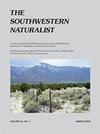FACTORS INFLUENCING THE DISTRIBUTION OF SUBMERGED AQUATIC MACROPHYTES IN JEMEZ MOUNTAIN STREAMS, NORTHERN NEW MEXICO, USA
IF 0.2
4区 环境科学与生态学
Q4 Agricultural and Biological Sciences
引用次数: 0
Abstract
Abstract Submerged aquatic macrophytes (SAMs) have been studied extensively in lotic ecosystems at low elevations, but few studies have been conducted in high-elevation systems, and factors controlling SAM distribution at high elevation are not well understood. After anecdotal and published documentation of abundant SAMs in high-elevation streams in the Jemez Mountains, northern New Mexico, USA, we wanted to determine what combination of physical factors are controlling the presence or absence of SAMs in the Jemez River watershed. We surveyed several sites on the three major river systems in the watershed along a gradient of elevation for physical factors, presence-absence, and percent cover of each taxa. Our results showed that SAMs were observed in 60% of surveyed sites that were associated with deeper, narrower, lower-velocity streams with low gradients. This evidence suggests that SAMs at high elevations are subject to similar abiotic controls found for SAM presence at lower elevations. Resumen Los macrófitos acuáticos sumergidos (SAMs, por sus siglas en inglés) han sido extensamente estudiados en los ecosistemas lóticos a bajas elevaciones, pero se han conducido pocos estudios en sistemas de alta elevación y los factores que controlan la distribución de los SAMs a gran altura no son bien comprendidos. Después de la documentación anecdótica y publicada de abundantes SAMs en los arroyos de alta elevación en las montañas de Jemez, en el norte de Nuevo México, EE.UU., queríamos determinar qué combinación de factores físicos están controlando la presencia o ausencia de SAMs en la cuenca del río Jemez. Muestreamos varios sitios en los tres principales sistemas fluviales de la cuenca a lo largo de un gradiente de elevación para determinar los factores físicos, la presencia-ausencia, y el porcentaje de cobertura de cada taxón. Nuestros resultados demostraron que los SAMs se observaron en el 60% de los sitios muestreados que estaban asociados con corrientes más profundas, más estrechas, de menor velocidad y con gradientes bajos. Esta evidencia sugiere que los SAMs en altas elevaciones están afectados por controles abióticos similares a los encontrados para la presencia de SAMs en elevaciones más bajas.影响美国新墨西哥州北部杰梅兹山溪水下大型水生植物分布的因素
摘要低海拔地区的湿地生态系统中广泛研究了淹没水生大型植物,但在高海拔地区的研究很少,控制高海拔地区水生大型植物分布的因素也不清楚。在美国新墨西哥州北部杰梅斯山脉高海拔河流中大量SAMS的轶事和文献发表后,我们想确定哪些物理因素组合控制着杰梅斯河流域SAMS的存在或不存在。我们沿着物理因素的海拔梯度,存在-缺席和每个分类的覆盖率,对流域三个主要河流系统的几个地点进行了调查。我们的结果表明,60%的调查地点观察到了SAMS,这些地点与较深、较窄、较低梯度的低速流有关。这一证据表明,在低海拔地区,高海拔地区的SAM也受到类似的非生物控制。摘要水下大型水生植物(SAMS)在低海拔生态系统中得到了广泛的研究,但对高海拔系统的研究很少,控制SAMS在高海拔分布的因素也不清楚。在美国新墨西哥州北部杰梅兹山脉高海拔河流中大量SAMS的轶事和出版文献之后,我们想确定哪些物理因素组合控制了杰梅兹河流域SAMS的存在或不存在。让我们沿着海拔梯度在盆地的三个主要河流系统中取样,以确定物理因素、存在-不存在以及每个分类单元的覆盖率。我们的结果表明,在60%的取样地点观察到SAMS,这些地点与更深、更窄、速度较慢和梯度较低的洋流有关。这一证据表明,高海拔地区的SAMS受到与在较低海拔地区发现的SAMS存在类似的非生物控制的影响。
本文章由计算机程序翻译,如有差异,请以英文原文为准。
求助全文
约1分钟内获得全文
求助全文
来源期刊

Southwestern Naturalist
环境科学-生态学
CiteScore
0.50
自引率
50.00%
发文量
47
审稿时长
18-36 weeks
期刊介绍:
The Southwestern Naturalist (a publication of the Southwestern Association of Naturalists since 1953) is an international journal (published quarterly) that reports original and significant research in any field of natural history. This journal promotes the study of plants and animals (living and fossil) in the multinational region that includes the southwestern United States, Mexico, and Central America. Appropriate submission of manuscripts may come from studies conducted in the countries of focus or in regions outside this area that report significant findings relating to biota occurring in the southwestern United States, Mexico, and Central America. Publication is in English, and manuscripts may be feature articles or notes. Feature articles communicate results of completed scientific investigations, while notes are reserved for short communications (e.g., behavioral observations, range extensions, and other important findings that do not in themselves constitute a comprehensive study). All manuscripts (feature articles and notes) require an abstract in both English and Spanish.
 求助内容:
求助内容: 应助结果提醒方式:
应助结果提醒方式:


